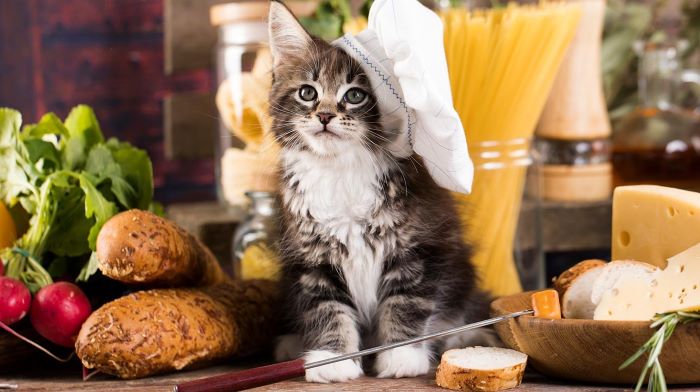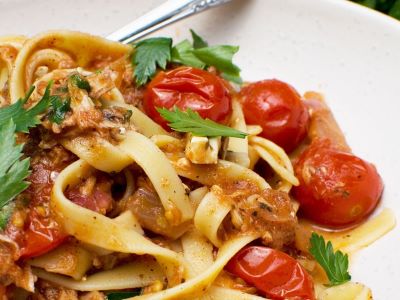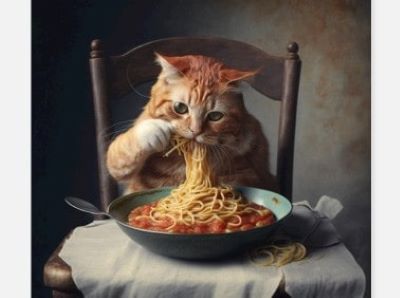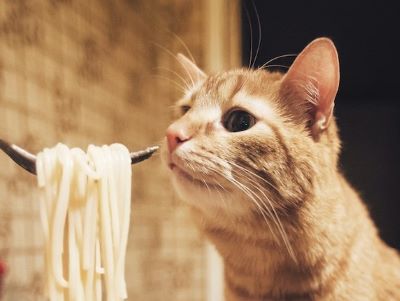As cat owners, we often wonder about what human foods are safe to share with our feline friends.
One common question that arises is whether cats can indulge in a plate of pasta.

While cats have specific dietary requirements, including a need for high-quality animal protein, it’s essential to understand the potential risks and benefits associated with feeding pasta to our furry companions.
Let’s delve into the topic and unravel the feline-feeding facts about pasta.
Can Cats Eat Pasta? Nutritional Concerns
Pasta primarily consists of refined wheat flour, which lacks the essential nutrients that cats require in their diet.
According to the experts at Cornell University, “Cats are obligate carnivores, which means that they rely on nutrients found only in animal products“.
Cats evolved as hunters that consume prey that contains high amounts of protein, moderate amounts of fat, and a minimal amount of carbohydrates, and their diet still requires these general proportions today.
Cats also require more than a dozen other nutrients, including vitamins, minerals, fatty acids, and amino acids.
Their bodies are designed to efficiently digest and absorb nutrients from meat sources.
Therefore, pasta alone does not provide the necessary nutrition to sustain a cat’s health and well-being.
How to Prepare Pasta for Cats?
To ensure your feline friend receives the perfect balance of nutrients while indulging in a pasta feast, follow these tempting steps:
- Let the water boil in a bubbling pot, salting it just right for flavor fireworks.
- Dip the pasta, allowing it to cook until it reaches the ideal height above the water, stirring occasionally to prevent any noodle mishaps.
- Bid farewell to excess liquid as you drain, ensuring the noodles are ready to be the star of the show.
- Introduce the superstar team of cubed chicken breast and well-drained tuna to the spotlight, flavors like culinary masters.
- Gently unite the delicious proteins and the hot, cooked noodles, creating a symphony of taste.
- Allow a moment for the feast to reach the perfect temperature, ensuring the delicate balance of warmth and delight
- Let their taste buds embark on a journey of delight.
- Bon appétit!, dear feline foodies.
This combination not only delivers essential proteins but also keeps their fur shining and skin flexible.

Potential Health Risks
Cats have a relatively short digestive tract and lack certain enzymes required for breaking down complex carbohydrates found in pasta.
While small amounts of pasta may not be immediately harmful, a cat’s digestive system is not optimized for processing and utilizing these types of foods efficiently.
Introducing pasta into a cat’s diet may lead to some of the following issues:
1. Obesity
Pasta is high in carbohydrates, which are not an essential part of a cat’s diet.
Cats have a limited ability to process carbohydrates and primarily require a protein-rich diet.
Consuming pasta regularly can lead to an imbalanced nutrient intake and an excess of calories.
This can contribute to weight gain and the development of obesity, a serious health concern in cats.
Obesity increases the risk of various health issues, including diabetes, joint problems, and heart disease.
Therefore, it is crucial to prioritize a cat’s nutritional needs and provide them with a balanced diet specifically developed for feline health to maintain a healthy weight and overall well-being.

2. Gastrointestinal Issues
Consumption of pasta can lead to digestive disturbances such as diarrhea, vomiting, and stomach discomfort[1].
The high carbohydrate content in pasta may disrupt the delicate balance of a cat’s digestive system, causing imbalances in gut bacteria and potential inflammation.
It is crucial to prioritize a cat’s dietary needs by providing them with a balanced diet that aligns with their natural carnivorous instincts, reducing the risk of gastrointestinal problems and maintaining their overall digestive health.
3. Allergic Reactions
Cats may develop allergies to ingredients commonly found in pasta, such as wheat or certain seasonings.
Allergic reactions can manifest as skin rashes, itching, or respiratory issues.
Veterinary guidance should be sought if any allergic symptoms occur.
Another concern is that pasta usually contains seasonings, sauces, or ingredients that are harmful to cats.
Garlic, onions, and certain herbs commonly used in pasta dishes can be toxic to cats, causing harm to their red blood cells[2].
Additionally, some pasta sauces may contain high levels of sodium or other additives that can be dangerous to a cat’s health.
Moderation Is the Key!
If you still wish to offer pasta to your cat as an occasional treat, it’s crucial to do so in moderation and with careful consideration.
Cooked plain pasta, without any seasoning or sauce, can be offered as a small portion.
However, it should never replace a cat’s regular balanced diet, which should consist primarily of high-quality cat food specifically developed to meet its nutritional requirements.

FAQs
Can Cats Eat Pasta or Rice?
Yes, pasta can eat pasta and rice, but it’s not healthy to feed your cat such meals as they are rich in starch which the cat cannot metabolize. What Foods Are Cats Not Allowed To Eat? Cats are not allowed to eat food containing chocolate, caffeine, onions, garlic, and raisins.
Can I Give Bread to My Cat?
Cats shouldn’t eat bread on a regular basis but, rather, reserve it for a once-in-a-while treat. Healthwise, there is nothing in baked bread that is bad for your cat, but the concern is that it also does not supply the nutrients your cat needs. Essentially, for cats, bread is considered a source of empty calories.
Why Does My Cat Want Pasta?
After taking Stan to the vet it was discovered that his sudden taste for Italian flavors was due to hyperthyroidism, a glandular disorder. The cat’s strange eating habits may have saved his life by revealing the condition.
Can Cats Digest Pasta?
The basic ingredients of pasta—flour, water, and eggs—are typically okay for cats to eat. The shape of the pasta also doesn’t matter due to its soft texture, so whether your preference is rotini or linguine, it should be fine for your cat to sample.
Wrap-up
While cats may show curiosity toward pasta, it’s important to prioritize their overall health and well-being.
Cats thrive on a diet that includes high-quality animal protein, and pasta does not provide the essential nutrients they need.
Feeding cats pasta regularly or in large amounts can lead to digestive issues and nutritional deficiencies.
It is always best to consult with a vet about appropriate dietary choices for your feline companion and rely on cat-specific foods that meet their nutritional needs.
Remember, the healthiest way to show love to your cat is by providing a balanced diet tailored to their unique needs, offering the right cat treats, and ensuring access to fresh water at all times.
Reference:
- The MSPCA-Angell. (2018, June 12). Chronic Gastrointestinal Disease in Cats- MSPCA-Angell.
- Baugher, J. (2023, January 3). Can Cats Eat Pasta? Find Out Here! – lovecats.org.

Patricia is a guardian to an exotic shorthair cat named Suz. She’s a professional cat trainer and behaviorist. She has expertise in writing on feline behavior, house training, and tips & tricks including product reviews of related products.

